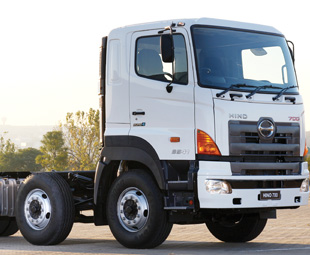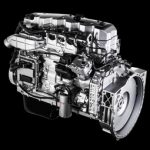Hino shows how construction is done

With the introduction of an 8×4 chassis, Hino claims a stake in a niche segment in the small, medium and micro enterprise (SMME) sector.
Hino’s two 700 8×4 construction models, introduced to the extra-heavy commercial vehicle (EHCV) sector last year, have seen their first full year in action, and 2014 was an important stepping stone for the 3541 Tipper and the 3541 Mixer. Aftersales proved to be merely a mandatory course; not having to deal with any hiccups thus far.
Hino now offers a comprehensive range of nine chassis designed to operate within the construction environment – from a 300 Series 915 freight carrier chassis, converted into the Tipper, that is typically used by smaller businesses (such as hardware stores for delivering smaller quantities of building materials) through to the two 700 Series 8×4 chassis aimed at the heavy construction segment.
Gert Agenbag, senior manager sales, Hino South Africa, adds proudly: “We were the first Japanese original equipment manufacturer (OEM) to introduce this configuration into the South African market and are making good progress. This year, we are looking to increase our volume by just over 50 percent. This involves a great deal of the Hino Total Support philosophy, which enables us to understand our customers better.”
Both Agenbag and Leslie Long, senior manager for marketing and demand planning, Hino South Africa, are quick to point out that, while the premium European brands are often viewed as the benchmark for quality, the Japanese brands are eroding this market with their durable and resilient “made for Africa” products – with the “big boys” in construction, such as Group5, recognising the Hino offering.
“It’s all about perception,” adds Long. “We’re changing the market perception every day.”
Hino introduced the 8×4 chassis in response to market demand, as Agenbag explains: “The heavy construction segment is alive and well, as witnessed by the number of construction projects on the go throughout Gauteng and other major cities.”
The Mixer chassis has an engine-driven, constant drive power take off. Agenbag says: “This opens up many application possibilities, other than use as a mixer. For example, concrete pumps of 46 m-plus, typically used on high-rise construction sites.” There is also a Hino 700 3541 8×4 freight carrier in the EHCV range, providing added capacity for the distribution markets.
“And,” he continues, “in terms of the quality, durability and reliability of Hino products, we are confident that our product will deliver on customer expectations.”
Long explains this claim: “Hino employs both build quality and design quality in delivering trucks to the market. Build quality obviously refers to controlling quality during the manufacturing process. Design quality refers to quality control in every step of the design, development and testing process. This impacts directly on the durability and reliability of Hino trucks under any operating conditions.”
Agenbag adds: “As we all know, the trucking business is not just about the product, and we have absolute confidence in the Hino dealer network’s ability to deliver the kind of aftersales service and parts back-up that will delight the customer.
“Hino’s total support philosophy of: ‘What’s good for the customer, is good for the dealer, is good for us’ will enable us to do just that,” he concludes.
Published by
Focus on Transport
focusmagsa




